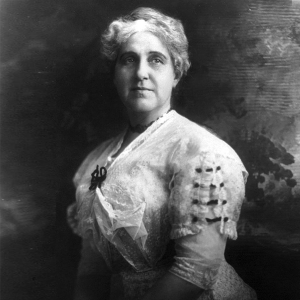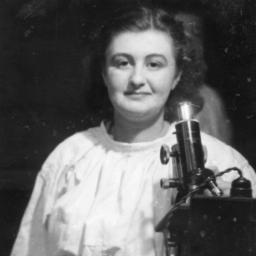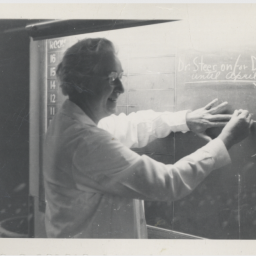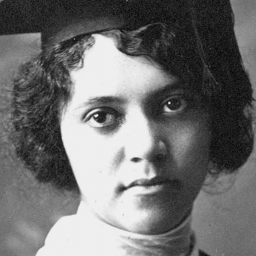Jane Arminda Delano

Although Jane Delano was related to President Franklin Delano Roosevelt, she made a name for herself as a nurse and a leader. She was known for her creative ways of taking care of patients and her ability to organize. She held many leadership positions, including the president of the Board of Directors of the American Journal of Nursing and the first chairman of the National Committee of the Red Cross Nursing Service. Jane Delano also served as the superintendent of the Army Nurse Corps. She dedicated her life to public service and inspired many women to become professional Red Cross nurses around the world.
Born on March 12, 1862, Jane Delano grew up with her mother in Montour Falls, New York. Her father died of yellow fever before she was born while he was serving in the Union Army during the Civil War. Jane Delano attended school in Montour Falls. She then moved to New York City to attend the Bellevue Hospital Training School for Nurses (now the Hunter-Bellevue School of Nursing). She graduated in 1886 and became the superintendent of nurses at Sandhills Hospital in Jacksonville, Florida. One of Delano’s main responsibilities was to take care of the patients with yellow fever. She placed mosquito nets over the windows and the patient care area even though scientists did not yet know that mosquitoes were carrying the disease. Delano’s new techniques were very successful. She moved to the west coast to take care of patients in Bisbee, Arizona during the typhoid epidemic. In 1891, she worked as the Superintendent of Nurses at the University Hospital in Philadelphia, Pennsylvania. This role inspired her to attend medical school in Buffalo, New York. However, Delano decided that she did not want to become a doctor. She continued working as a nurse and supervised a shelter for girls called the House of Refuge in New York City. In 1902, Delano returned to Bellevue Hospital to lead the training school for nurses.
By 1909, Delano was an important person in the nursing world. She accepted a position as the president of the Associated Alumnae. She also served as president of the Board of Directors of the American Journal of Nursing. A year later she became the chairman of the American Red Cross Nursing Service and the superintendent of the Army Nurse Corps. During this time, she also applied to the nursing corps to support the Army during the war. Even though she was over the age limit of 45, the Army accepted her application. Delano helped increase the number of women in the nursing reserves. She led the American Red Cross Nursing Service to become the officially recognized nursing reserve for the Army, Navy, and Public Health Service. After serving in the Army Nurse Corps for many years, Delano resigned in 1912. She wanted to volunteer full time with the Red Cross. She traveled around the world recruiting women to train as nurses and to volunteer for the Army. By the time the United States entered World War I in 1917, over 8,000 nurses were ready to serve immediately. Thanks to her hard work, by November of 1918 at least 18,732 nurses had volunteered to serve in the war. Without Delano’s help, there would not have been enough nurses to treat the injured solders and refugees.
After World War I, Delano continued to recruit nurses and medical workers. She established the Red Cross Town and Country Nursing Service. She also co-wrote a textbook and created courses in Elementary Hygiene and Home Care of the Sick. She traveled to Europe to visit hospitals and the nurses she helped recruit. While in France, she became very sick and needed surgery. After her surgery, her condition got worse and she was unable to continue working. She died on April 15, 1919 in Savenay, France and was buried there. Her reported last words were, “What about my work, I must get back to my work.” [1] A year later, the Army Quartermaster Corps requested to bring Delano’s body back to the United States. Delano was moved to the nurse’s corner at Arlington National Cemetery in Virginia. She was awarded the Distinguished Service Medal after she died for her work as the Director of the Department of Nursing at the American Red Cross. Additionally, nurses paid for a memorial to honor her and the other nurses who died in the war. A dedication service was held in April 1934 in the garden at Red Cross National Headquarters in Washington, DC.
- "JANE DELANO Founder of the American Red Cross Nursing Service." American Red Cross. 2018. Accessed October 9, 2018. https://www.redcross.org/about-us/who-we-are/history/nursing.html. Pp. 4
- Chaudhary, Yasmin. "WWI Women: Jane Arminda Delano." The United States World War I Centennial Commission. 2013. Accessed October 10, 2018. https://www.worldwar1centennial.org/index.php/
- "Jane A. Delano." American Association for the History of Nursing. 2018. Accessed October 10, 2018. https://www.aahn.org/delano.
- "JANE DELANO Founder of the American Red Cross Nursing Service." American Red Cross. 2018. Accessed October 9, 2018. https://www.redcross.org/about-us/who-we-are/history/nursing.html.
- Peterson, Moya. "Jane A. Delano - Superintendent of US Army Nurse Corps." Medicine in the First World War. July 26, 2018. Accessed October 10, 2018. http://www.kumc.edu/wwi/essays-on-first-world-war-medicine/index-of-essays/biography/jane-delano.html.
- Sarnecky, Mary T. "Miss Jane A. Delano: 2d Superintendent, Army Nurse Corps." The Army Nurse Corps Association. 2018. Accessed October 10, 2018. https://e-anca.org/History/Superintendents-Chiefs-of-the-ANC/Miss-Jane-A-Delano.
- United States Adjutant-General's Office. Congressional Medal of Honor, the Distinguished Service Cross and the Distinguished Service Medal Issued by the War Department since April 6, 1917: Up to and including General Orders, No. 126, War Department, November 11, 1919.Washington: Govt. Print. Off., 1920.
MLA - Alexander, Kerri Lee. "Jane Arminda Delano." National Women's History Museum. National Women's History Museum, 2019. Date accessed.
Chicago - Alexander, Kerri Lee. "Jane Arminda Delano." National Women's History Museum. 2019. www.womenshistory.org/education-resources/biographies/jane-arminda-delano.




